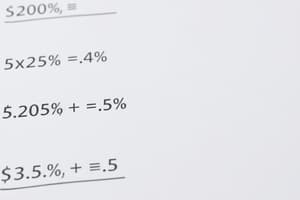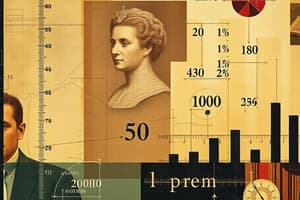Podcast
Questions and Answers
What is the volume of a rectangular prism with dimensions 2 cm, 4 cm, and 5 cm?
What is the volume of a rectangular prism with dimensions 2 cm, 4 cm, and 5 cm?
- 40 cm³ (correct)
- 60 cm³
- 30 cm³
- 50 cm³
Pressure is calculated using the formula Force ÷ Area.
Pressure is calculated using the formula Force ÷ Area.
True (A)
If a force of 10 Newtons is applied to an area of 20 cm², what is the pressure produced?
If a force of 10 Newtons is applied to an area of 20 cm², what is the pressure produced?
0.5 N/cm²
The formula for calculating mass is _____ x Volume.
The formula for calculating mass is _____ x Volume.
Match the following unit conversions with their values:
Match the following unit conversions with their values:
What does 'direct proportion' mean?
What does 'direct proportion' mean?
In a direct proportion, y is expressed as _____x, where k is the multiplier.
In a direct proportion, y is expressed as _____x, where k is the multiplier.
A direct proportion graph can be represented as a curve.
A direct proportion graph can be represented as a curve.
What is the percentage increase when an amount is increased first by 10% and then by 12%?
What is the percentage increase when an amount is increased first by 10% and then by 12%?
The multiplier to increase an amount by 12% is 1.12.
The multiplier to increase an amount by 12% is 1.12.
What formula is used to calculate speed?
What formula is used to calculate speed?
Density is calculated using the formula _____ = Mass ÷ Volume.
Density is calculated using the formula _____ = Mass ÷ Volume.
Match the following measurements with their formulas:
Match the following measurements with their formulas:
If a piece of metal weighs 40g and has a volume of 4cm³, what is its density?
If a piece of metal weighs 40g and has a volume of 4cm³, what is its density?
45 minutes is equal to 0.75 hours.
45 minutes is equal to 0.75 hours.
Calculate the volume of a block of ice that measures 5cm by 2cm by 4cm.
Calculate the volume of a block of ice that measures 5cm by 2cm by 4cm.
What is the relationship between y and x given that y is proportional to $x^2$?
What is the relationship between y and x given that y is proportional to $x^2$?
For directly proportional relationships, k remains constant.
For directly proportional relationships, k remains constant.
If when x = 2, y = 16, what is the value of k in the equation $y = kx^2$?
If when x = 2, y = 16, what is the value of k in the equation $y = kx^2$?
The equation representing an inverse relationship between y and x is $y = \frac{k}{x}$, where k = _____ when x = 4 and y = 25.
The equation representing an inverse relationship between y and x is $y = \frac{k}{x}$, where k = _____ when x = 4 and y = 25.
Match the following relationships with their equations:
Match the following relationships with their equations:
Which equation correctly represents g in terms of f when g is proportional to the square root of f?
Which equation correctly represents g in terms of f when g is proportional to the square root of f?
If x decreases, y increases in an inversely proportional relationship.
If x decreases, y increases in an inversely proportional relationship.
What is the value of y when x = 2, given the equation for inverse proportionality with k = 100?
What is the value of y when x = 2, given the equation for inverse proportionality with k = 100?
Flashcards
Percentage Multiplier
Percentage Multiplier
The multiplier used to increase a value by a certain percentage. For example, the multiplier for a 10% increase is 1.10, which is obtained by dividing 110% by 100.
Overall Percentage Increase
Overall Percentage Increase
The overall percentage increase when multiple percentage increases are applied consecutively. It is calculated by multiplying the individual multipliers together.
Compound Measure
Compound Measure
A measure that combines two different units, often used to describe quantities such as speed, density, and pressure. It is expressed as a ratio of two units.
Speed
Speed
Signup and view all the flashcards
Density
Density
Signup and view all the flashcards
Volume
Volume
Signup and view all the flashcards
Mass
Mass
Signup and view all the flashcards
Compound Interest
Compound Interest
Signup and view all the flashcards
Pressure
Pressure
Signup and view all the flashcards
Direct Proportion
Direct Proportion
Signup and view all the flashcards
Pressure Formula
Pressure Formula
Signup and view all the flashcards
Direct Proportion Formula
Direct Proportion Formula
Signup and view all the flashcards
Direct Proportion Graph
Direct Proportion Graph
Signup and view all the flashcards
Finding the Multiplier (k)
Finding the Multiplier (k)
Signup and view all the flashcards
Converting Units
Converting Units
Signup and view all the flashcards
Common Multiplier in Direct Proportion
Common Multiplier in Direct Proportion
Signup and view all the flashcards
Inverse Proportion
Inverse Proportion
Signup and view all the flashcards
Multiplier (k)
Multiplier (k)
Signup and view all the flashcards
Direct Proportion with Powers
Direct Proportion with Powers
Signup and view all the flashcards
Direct Proportion with Square Root
Direct Proportion with Square Root
Signup and view all the flashcards
Equation for Direct/ Inverse Proportion
Equation for Direct/ Inverse Proportion
Signup and view all the flashcards
Proportionality Factor
Proportionality Factor
Signup and view all the flashcards
Writing an Equation for Direct/Inverse Proportion
Writing an Equation for Direct/Inverse Proportion
Signup and view all the flashcards
Study Notes
Repeated Percentages
- To increase a quantity by 10%, multiply by 1.10
- To increase a quantity by 12%, multiply by 1.12
- To find the overall percentage increase when increasing by multiple percentages, multiply the individual multipliers.
Compound Percentages
- Compound interest calculates interest on both the original principal and the accumulated interest from prior periods.
- If an amount increases by 10% each year, multiply the initial amount by 1.10 a 3 year period to determine the final amount.
- Alternatively, if an amount depreciates by 10% each year, multiply the initial amount by 0.90 for a 3 year period to determine the final amount.
Compound Measures - Units
- Compound measures are units that consist of two measurements.
- Examples:
- Density: mass/volume (g/cm³, kg/m³ kg/L)
- Speed: distance/time (m/s, km/h, mph)
- Pressure: force/area (N/m², N/cm²)
- Fuel consumption: distance/volume (km/L, mpg)
Compound Measures - Speed
- Speed = Distance / Time
- Time = Distance / Speed
- Distance = Speed x Time
- Convert minutes to hours to use in speed calculations.
Compound Measures - Density
- Density = Mass / Volume
- Volume = Mass / Density
- Mass = Density x Volume
- Use formulas to calculate missing parameters regarding density, mass and volume.
Compound Measures - Pressure
- Pressure = Force / Area
- Area = Force / Pressure
- Force = Pressure x Area
- Pressure units: N/cm², N/m², N/km²
Compound Measures - Converting Measurements
- Use conversion factors to change units of measurement.
- Example conversions: km/h to mph, km/h to km/s, mph to m/s
Direct Proportion
- Two sets of values are directly proportional if they have a common multiplier.
- In a direct proportion graph, the line passes through the origin (0,0)
- Direct proportion equations are of the form y = kx, where k is the constant of proportionality.
- To find k, use the given x and y values. Examples include find a constant k is known in relation to x and y when x is known
Direct Proportion - Without Powers
- The formula y=kx represents direct proportion, where k is the constant of proportionality.
- To find the constant, divide a value of y by its corresponding value of x.
Direct Proportion - With Powers
- If y is directly proportional to the square of x, the equation is y = kx².
- If y is directly proportional to the cube of x, the equation is y = kx³.
- Use given values to solve for the constant k and form the correct equation.
Inverse Proportion
- Two values are inversely proportional if one value increases as the other decreases.
- The formula representing inverse proportion is y=k/x.
- To find the constant k, multiply a value of x and its corresponding value of y.
Studying That Suits You
Use AI to generate personalized quizzes and flashcards to suit your learning preferences.




